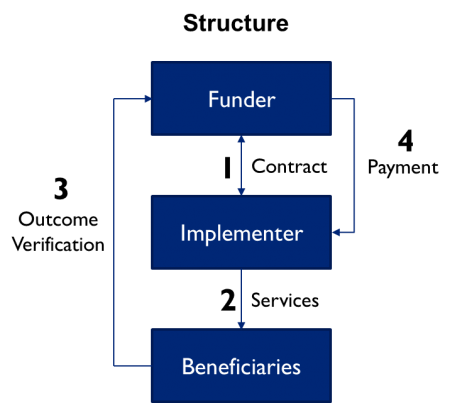4.5.11. Pay for Results: Performance-based Contracts (PBCs)
DESCRIPTION
Contracts or grant agreements where payments are disbursed upon accomplishment of predetermined results, rather than for inputs or “best efforts” in achieving outcomes. These arrangements are principally between funders and implementers/service providers; however, they can also be between funders and recipient governments, which then subcontract service provision (e.g., the Millennium Challenge Corporation’s approach, the World Bank’s PforR approach, and Center for Global Development’s proposed Cash on Delivery Aid approach) (See: Pay for Performance Primer).
Today, performance-based contracts are the most commonly used Pay for Results mechanism at USAID. Funders and implementers agree on pre-determined outcome metrics and verification methods, with the implementer given latitude on how it will accomplish the metrics (which could include the implementer making PBC sub- awards). Few PBC contracts or grants are “pure,” meaning 100% of a contract is structured as a PBC. Most are hybrids where implementers are paid part of their contracts on a unit or input basis, while the remainder of payments are linked to successful performance relative to target outcomes.
Image

CONSTRAINTS ADDRESSED
- Appropriate capital to meet borrower needs
- Production costs associated with target sector/region
- Rate of return on lending in target sector/region
ADVANTAGES
Coming soon.
DISADVANTAGES
Defining performance specifications and agreeing on verification methods; Designing the incentive payment amount and structure to avoid overpayment or perverse incentives (e.g., reduced service quality, fraud, ignoring unrewarded activities, encouraging demand for unnecessary services, undermining sustainability); Getting all parties to embrace outcome-based service delivery; Proving the effectiveness of PBCs without using counterfactuals
MUST HAVE’S, CRITICAL POINTS, OR QUESTIONS TO CONSIDER
PBCs are most appropriate when targeted outputs and outcomes are well defined, measurable, and plausible to accomplish; service providers have experience delivering desired outcomes and have interest in finding new efficiencies; data sources and monitoring systems exist to track and validate outcomes; donors/funders are comfortable giving service providers room to innovate to achieve outcomes; and the cost of achieving outcomes can be fairly priced.
VIGNETTE: UJJWAL FAMILY PLANNING PROGRAM (INDIA)
SITUATION
High, unmet needs for family planning in two Indian states
STRUCTURE
Performance-based contract with seventy payment milestones over a 36-month period to encourage health-related outcomes, including establishment of clinics and disbursement of family planning products. Invoicing for each milestone payment required the implementer to develop a technical report to prove the outcomes achieved using verifiable data, and then submitting this to the funder and a third-party assessor that reported periodically to the client on deliverable satisfaction through sample surveys and interviews on the ground.
IMPACT
Generated 3.58 million years of protection for couples (Couple Years Protection); Reached more than 1.5 million additional family planning users (twice the 2016 target of 780,000); 306 UJJWAL franchisee clinics were created; 100 are accredited

